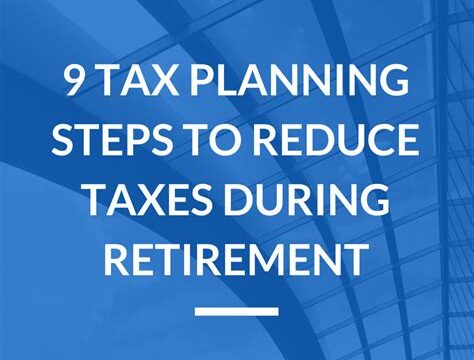Understanding the basics of tax planning
When it comes to managing your finances, understanding the basics of tax planning is essential. Tax planning involves taking deliberate actions to minimize your tax liability and maximize your tax benefits. By implementing effective tax planning strategies, you can ensure that you are only paying the taxes that you are legally obligated to pay, while also taking advantage of any available deductions or credits.
There are several key concepts that you should be familiar with in order to grasp the basics of tax planning. One important concept is the difference between tax avoidance and tax evasion. While tax evasion is illegal and involves intentionally underreporting income or inflating deductions, tax avoidance is a legitimate practice that involves using legal methods to reduce your tax liability.
An important aspect of tax planning is understanding the various types of taxable income. This includes income from sources such as employment, self-employment, investments, and rental properties. Different types of income may be taxed at different rates or may be subject to different deductions or exemptions. By having a clear understanding of your sources of income, you can make more informed decisions when it comes to tax planning.
- One strategy for reducing your tax liability is to take advantage of deductions and credits. Deductions are expenses that can be subtracted from your taxable income, while credits directly reduce the amount of tax you owe. Common deductions include mortgage interest, student loan interest, and medical expenses. Credits, on the other hand, can be even more valuable as they provide a dollar-for-dollar reduction in your tax liability. Common credits include the Child Tax Credit, the Lifetime Learning Credit, and the Earned Income Tax Credit.
| Taxable Income | Tax Rate |
|---|---|
| Income up to $9,950 | 10% |
| Income between $9,951 and $40,525 | 12% |
| Income between $40,526 and $86,375 | 22% |
| Income between $86,376 and $164,925 | 24% |
Another important aspect of tax planning is understanding the different tax brackets. Tax brackets determine the rate at which your income is taxed. As your income increases, you may move into a higher tax bracket, which means that a greater percentage of your income will be taxed. By structuring your finances in a way that keeps you in a lower tax bracket, you can minimize your tax liability.
Overall, understanding the basics of tax planning is crucial for managing your finances effectively. By taking advantage of deductions and credits, understanding the different types of taxable income, and being aware of the tax brackets, you can ensure that you are making informed decisions that maximize your tax benefits. Remember, tax planning is a continuous process, and it is always a good idea to consult with a professional tax advisor or accountant to help you navigate the complexities of the tax system.
Assessing your current financial situation
Assessing your current financial situation is a crucial step in creating a successful financial plan. It involves evaluating your current income, expenses, assets, and liabilities to get a clear picture of your overall financial health. By taking the time to assess your financial situation, you can identify areas for improvement, set realistic goals, and make informed decisions about your finances.
One of the first things you should do when assessing your financial situation is to calculate your net worth. This involves subtracting your total liabilities from your total assets. Your assets can include your savings, investments, property, and other valuable possessions, while your liabilities may include your loans, credit card debt, and other financial obligations. Calculating your net worth can help you understand your overall financial standing and determine if you are on track to meet your financial goals.
In addition to calculating your net worth, it is important to evaluate your income and expenses. Take a careful look at your monthly income and determine if it is sufficient to cover your expenses. Make a list of your regular expenses, including housing costs, utilities, transportation, groceries, and entertainment. Compare your expenses to your income and identify any areas where you may be overspending or have the opportunity to save money.
- Create a budget to track your income and expenses
- Find areas where you can cut back on expenses
- Set aside money for emergencies and savings
- Consider your long-term financial goals
Once you have assessed your income, expenses, and net worth, it is important to consider your current financial goals. What are you working towards? Are you saving for retirement, buying a home, or planning for your children’s education? Take some time to identify your short-term and long-term financial goals. This will help you prioritize your spending, savings, and investments and create a plan that aligns with your objectives.
| Steps for Assessing Your Current Financial Situation |
|---|
| Calculate your net worth by subtracting liabilities from assets |
| Evaluate your income and expenses |
| Identify areas for potential savings or financial improvement |
| Set financial goals that align with your values and objectives |
An important part of assessing your financial situation is to also consider any debt you may have. Evaluate your current debts, such as credit card balances, student loans, and mortgages. Determine the interest rates, minimum payments, and repayment terms for each debt. This will help you understand how your debt is impacting your overall financial health and make decisions about debt repayment strategies.
In conclusion, assessing your current financial situation is essential for creating a strong foundation for your overall financial plan. It allows you to understand your net worth, evaluate your income and expenses, set realistic goals, and make informed decisions about your finances. By taking the time to assess your financial situation, you can gain control over your finances, work towards your long-term goals, and ultimately achieve financial success.
Exploring tax-deferred retirement accounts
When it comes to planning for retirement, one of the key considerations is finding ways to minimize tax obligations. One effective strategy to explore is investing in tax-deferred retirement accounts. These accounts, such as traditional IRAs and 401(k)s, offer individuals an opportunity to save for retirement while enjoying potential tax benefits.
One of the primary advantages of tax-deferred retirement accounts is the ability to contribute pre-tax income. By contributing to these accounts, individuals can reduce their taxable income for the year, potentially lowering their overall tax liability. This allows individuals to keep more of their hard-earned money and allocate it towards their retirement savings.
In addition to the immediate tax benefits, another advantage of tax-deferred retirement accounts is the ability to grow investments on a tax-deferred basis. This means that any earnings or capital gains within the account are not subject to taxes until withdrawals are made in retirement. This allows investors to potentially benefit from compounding growth over time, as taxes are deferred until retirement when individuals may be in a lower tax bracket.
It is important to note that while tax-deferred retirement accounts offer significant advantages, there are some limitations and considerations to keep in mind. For example, early withdrawals from these accounts may be subject to penalties and taxes. Additionally, once individuals reach a certain age (typically 72), they are required to start taking withdrawals from these accounts, known as Required Minimum Distributions (RMDs).
To make the most of tax-deferred retirement accounts, it is crucial to develop a solid investment strategy that aligns with your retirement goals and risk tolerance. Consider diversifying your investments across different asset classes and regularly reviewing and rebalancing your portfolio. This can help maximize potential returns while minimizing risks.
In conclusion, exploring tax-deferred retirement accounts is an essential aspect of retirement planning. By taking advantage of the tax benefits and potential growth opportunities offered by these accounts, individuals can work towards building a secure financial future. However, it is important to consult with a financial advisor or tax professional to ensure you fully understand the tax implications and make informed decisions that align with your specific financial situation and goals.
Taking advantage of tax-free investments
When it comes to investing, one of the key factors to consider is taxes. Paying taxes on your investment earnings can significantly impact your overall returns. However, there are certain investment options that offer tax-free benefits, allowing you to maximize your earnings. Understanding and taking advantage of these tax-free investments can have a significant positive impact on your financial future.
One of the most popular tax-free investments is a Roth IRA. With a Roth IRA, you contribute after-tax dollars, meaning you’ve already paid taxes on the money you invest. The advantage of a Roth IRA is that your earnings grow tax-free and withdrawals in retirement are also tax-free. This can be especially beneficial if you anticipate being in a higher tax bracket during retirement.
Another tax-free investment option to consider is a health savings account (HSA). An HSA allows you to save money for medical expenses, and contributions are tax-deductible. The earnings in your HSA grow tax-free, and withdrawals are tax-free as long as they are used for qualified medical expenses. This can be a valuable tool for managing healthcare costs and saving for future medical needs.
List of tax-free investments:
| Investment Option | Tax Benefits |
|---|---|
| Roth IRA | Earnings and withdrawals are tax-free |
| Health Savings Account (HSA) | Contributions, earnings, and withdrawals are tax-free for qualified medical expenses |
| Municipal Bonds | Interest income is generally exempt from federal taxes |
| 529 College Savings Plan | Earnings are tax-free when used for qualified education expenses |
It’s important to note that not all tax-free investment options are suitable for everyone. Each individual’s financial situation and investment goals are unique, and it’s advisable to consult with a financial advisor before making decisions. They can help you assess which tax-free investments align with your specific needs and objectives.
By taking advantage of tax-free investments, you have the opportunity to grow your wealth and keep more of your hard-earned money. Whether it’s through a Roth IRA, an HSA, or other tax-free options, these investments can provide essential benefits for your financial future. Start exploring your options today and make informed decisions that will help you secure a tax-efficient investment strategy.
Maximizing retirement contributions for tax benefits
When it comes to planning for retirement, one key aspect that individuals often overlook is the potential tax benefits that can be gained by maximizing their retirement contributions. By taking full advantage of retirement accounts and making smart financial decisions, individuals can minimize their tax liabilities while building a secure financial future.
To start with, it is important to understand the basics of tax planning in relation to retirement contributions. Tax planning involves strategically managing your finances to minimize the amount of tax you owe. By making the maximum allowable contributions to retirement accounts, such as IRAs (Individual Retirement Accounts) and 401(k) plans, individuals can reduce their taxable income and potentially lower their overall tax bracket.
- Make sure you are aware of the contribution limits set by the IRS for various retirement accounts, such as Traditional and Roth IRAs, 401(k) plans, and self-employed retirement plans. For example, for the year 2021, the contribution limit for a Traditional or Roth IRA is $6,000, with an additional $1,000 catch-up contribution for individuals aged 50 and above.
- Consider contributing to employer-sponsored retirement plans, such as a 401(k) or 403(b) plan, especially if your employer offers a matching contribution. Employer matches are essentially free money and can significantly boost your retirement savings while providing immediate tax benefits.
| Retirement Account | Contribution Limit (2021) |
|---|---|
| Traditional or Roth IRA | $6,000 ($7,000 if aged 50 or above) |
| 401(k) or 403(b) plan | $19,500 ($26,000 if aged 50 or above) |
Another effective strategy for maximizing retirement contributions is to consider utilizing a combination of retirement accounts. By diversifying your retirement savings across different account types, you can take advantage of the unique tax benefits each account offers. For example, Traditional IRAs offer a tax deduction on contributions, while Roth IRAs allow for tax-free withdrawals in retirement.
Furthermore, individuals should be aware of the tax implications of early withdrawals from retirement accounts. While it may be tempting to tap into retirement savings in times of financial need, it is important to consider the potential tax penalties and the long-term impact on your retirement savings. By sticking to a long-term retirement plan and utilizing other sources of income, such as emergency funds or taxable investments, you can avoid unnecessary taxes and penalties.
In conclusion, maximizing retirement contributions is not only crucial for building a secure financial future but also offers significant tax benefits. By understanding the basics of tax planning, being aware of contribution limits, taking advantage of employer matches, and diversifying retirement savings, individuals can make the most of their retirement accounts while minimizing their tax liabilities. Remember to consult with a financial advisor or tax professional to ensure you are making the best decisions for your specific circumstances.
Implementing strategic asset allocation for tax efficiency
Implementing strategic asset allocation for tax efficiency
Implementing strategic asset allocation is a vital part of any tax-efficient investment plan. By strategically allocating your assets, you can minimize your tax liability and maximize your investment returns. It involves determining the optimal mix of assets, such as stocks, bonds, and cash, based on your financial goals, risk tolerance, and time horizon. Successfully implementing this strategy can enhance your long-term investment performance and help you achieve your financial objectives.
A key aspect of strategic asset allocation is diversification. By spreading your investments across different asset classes, you can reduce the risk associated with any single investment. This diversification helps to protect your portfolio from market downturns and volatility. However, not all asset allocations are created equal when it comes to tax efficiency.
When considering tax efficiency, it is important to take into account the tax implications of your investment choices. Different types of assets are subject to different tax treatments, such as capital gains tax, dividend tax, and interest income tax. By strategically allocating your assets, you can potentially minimize your tax liability by investing in tax-efficient asset classes.
- Equities: Stocks and equity-based investments can be tax-efficient if held for the long term. This is because long-term capital gains on stocks are often taxed at a lower rate than short-term gains. Additionally, qualified dividends from certain stocks can receive preferential tax treatment.
- Bonds: Bonds and fixed-income investments generate taxable interest income. However, certain types of bonds, such as municipal bonds, may offer tax advantages. Interest income from municipal bonds issued by state or local governments is often tax-free at the federal level and may also be exempt from state income tax.
- Real Estate: Real estate investments, such as rental properties or real estate investment trusts (REITs), can provide tax advantages. Rental income from investment properties can be offset by deductible expenses, such as property taxes and mortgage interest. REITs also offer potential tax advantages, as they are required to distribute at least 90% of their taxable income to shareholders, resulting in potential tax benefits for investors.
In addition to asset class selection, another consideration for tax-efficient asset allocation is the location of your investments. Different types of accounts, such as taxable brokerage accounts, individual retirement accounts (IRAs), and employer-sponsored retirement plans, have different tax advantages and disadvantages. By strategically locating your investments in tax-advantaged accounts, you can further optimize your tax efficiency.
| Tax-Advantaged Account | Tax Benefits |
|---|---|
| Traditional IRA or 401(k) | Contributions may be tax-deductible, and investment growth is tax-deferred until withdrawal. |
| Roth IRA or Roth 401(k) | Contributions are made with after-tax dollars, but qualified withdrawals are tax-free, including investment growth. |
| Taxable Brokerage Account | Investment gains are subject to capital gains tax, but there are no restrictions on contributions or withdrawals. |
By understanding the basics of tax planning and assessing your current financial situation, you can better implement strategic asset allocation for tax efficiency. Consult with a financial advisor or tax professional to develop a personalized investment strategy that aligns with your goals and takes advantage of the available tax benefits.
Utilizing tax-efficient withdrawal strategies
Utilizing tax-efficient withdrawal strategies is an essential aspect of financial planning, especially during retirement. Withdrawing money from your retirement accounts in a tax-efficient manner can help you maximize your after-tax income and make your savings last longer.
One of the key strategies for tax-efficient withdrawals is to minimize your taxable income. This can be done by carefully planning your withdrawals from different types of retirement accounts, such as traditional IRAs, 401(k)s, and Roth IRAs. By strategically combining withdrawals from these accounts, you can lower your overall tax liability.
Another strategy is to take advantage of tax-favored capital gains rates. If you have investments in taxable brokerage accounts, consider selling those assets that qualify for long-term capital gains treatment. Long-term capital gains tax rates are typically lower than ordinary income tax rates, so this can help you reduce your tax bill when withdrawing funds.
Additionally, managing your Social Security benefits can play a crucial role in tax-efficient withdrawals. If you receive Social Security benefits along with other sources of retirement income, properly structuring your withdrawals can help you minimize the portion of your benefits subject to federal income taxes. This may involve adjusting the timing and amount of your withdrawals to stay within certain income thresholds.
To summarize, by utilizing tax-efficient withdrawal strategies, you can effectively manage your income during retirement and optimize your tax situation. It’s important to work with a qualified financial advisor or tax professional who can help you navigate the complexities of tax laws and tailor a withdrawal strategy that aligns with your financial goals.
Considering tax implications of Social Security benefits
In order to make informed financial decisions, it is crucial to understand the tax implications of Social Security benefits. Social Security benefits are an essential source of income for many retirees, but it is important to recognize that they may be subject to federal income taxes. By considering the potential tax implications, individuals can better plan and optimize their retirement income.
One key aspect to understand is the Provisional Income. Provisional Income is used to determine whether a portion of Social Security benefits is taxable. It is calculated by adding one’s adjusted gross income, any tax-exempt interest, and 50% of the Social Security benefits received. The resulting amount is then compared to specific income thresholds to determine if any benefits are subject to taxation.
It is also important to be aware of the different tax strategies that can help minimize the tax burden on Social Security benefits. One such strategy is the timing of retirement account withdrawals. By carefully managing when and how much money is withdrawn from retirement accounts, individuals can potentially reduce the impact on their taxable income and avoid pushing their Provisional Income above the threshold.
- Optimize other sources of income: By diversifying sources of income, individuals can minimize the taxable portion of their Social Security benefits. This can be achieved by leveraging tax-free investments such as Roth IRAs and municipal bonds.
- Consider delaying Social Security benefits: Delaying Social Security benefits beyond the minimum age of eligibility (currently 62 years old) can result in higher monthly benefits, thereby potentially reducing the need for additional taxable income sources.
- Stay informed about changes in tax laws: Tax laws and regulations frequently change. Staying up to date with these changes can help retirees make informed decisions regarding their Social Security benefits and overall tax planning strategies. Consulting with a financial advisor or tax professional may also be beneficial.
Understanding the tax implications of Social Security benefits is crucial for financial planning in retirement. By considering these implications and implementing tax-efficient strategies, individuals can make the most of their retirement income and minimize their tax liability. Taking the time to educate oneself about these considerations can lead to a more secure and financially stable retirement.
| Benefit Amount | Taxable Percentage |
|---|---|
| $0 – $25,000 | 0% |
| $25,000 – $34,000 | 50% |
| Above $34,000 | 85% |
Frequently Asked Questions
Q1: What is tax planning and why is it important?
Tax planning refers to the process of organizing your finances in a way that legally minimizes your tax liability. It involves proactive strategies such as taking advantage of deductions, credits, and exemptions to reduce the amount of income tax you owe. Tax planning is important because it helps you save money, optimize your financial situation, and ensure compliance with tax laws.
Q2: How do I assess my current financial situation for tax planning purposes?
To assess your current financial situation for tax planning, you need to gather all relevant financial information including income, expenses, investments, assets, and liabilities. Calculate your taxable income, review your tax returns from previous years, and analyze any changes in your financial circumstances. This evaluation will provide insights for developing effective tax planning strategies.
Q3: What are tax-deferred retirement accounts and how can they help with tax planning?
Tax-deferred retirement accounts, such as traditional IRAs and 401(k) plans, allow you to contribute pre-tax income, which reduces your taxable income in the year of contribution. The earnings on these accounts are not taxed until you withdraw them in retirement. By contributing to tax-deferred retirement accounts, you can lower your current tax liability and potentially benefit from a lower tax bracket in retirement.
Q4: What are tax-free investments and how can they benefit me?
Tax-free investments, such as municipal bonds or Roth IRAs, offer earnings that are not subject to federal income tax. By investing in these vehicles, you can potentially generate tax-free income and maximize your after-tax returns. Tax-free investments are beneficial for individuals in higher tax brackets who wish to minimize their tax burden.
Q5: How can I maximize my retirement contributions for tax benefits?
You can maximize your retirement contributions for tax benefits by contributing the maximum allowable amount to employer-sponsored retirement plans like 401(k)s or contributing to individual retirement accounts (IRAs). These contributions reduce your taxable income, potentially lower your tax liability, and allow for tax-deferred growth or tax-free withdrawals in retirement.
Q6: What is strategic asset allocation for tax efficiency?
Strategic asset allocation involves diversifying your investment portfolio across different asset classes, such as stocks, bonds, and real estate, to achieve long-term financial goals while considering the tax implications. By strategically allocating your assets, you can potentially optimize your tax situation by minimizing capital gains taxes, strategically timing investment sales, and taking advantage of tax-efficient investments.
Q7: How should I consider the tax implications of Social Security benefits?
It is important to consider the tax implications of Social Security benefits as a portion of these benefits may become taxable based on your total income. The taxable amount is determined by a formula that considers your provisional income. Understanding these tax rules can help you plan your retirement income sources effectively and potentially reduce the tax burden on your Social Security benefits.





